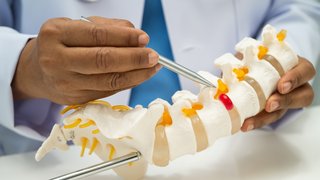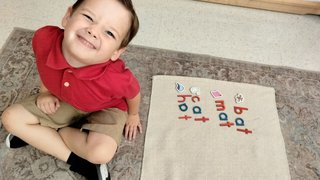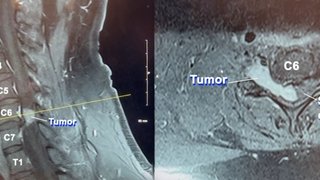How we 3D-print a model of your spine to enhance complex back surgery
July 15, 2021

The spine is an intricate web of bone, muscle, soft tissue, and nerves that works in concert to help us move, walk, and stand tall. So, when a disease or traumatic injury damages the spine, the repair is no simple task.
Unlike some other essential body structures such as the heart, lungs, or colon, there is no easy way to fully visualize all the nooks and crannies of the spine. Even the most advanced imaging technology and navigation software can’t give us the visual and tactile advantages we could get by laying hands and eyes on damaged tissue or bone.
But recently we discovered that a simple arts and crafts tool – the 3D printer – can enhance how we plan our surgical approaches, educate patients about their spine health, and train residents in complex spinal surgery.
In 2019, I purchased a small 3D printer so I could make decorative initials for my son’s crib. After that, I took up printing as a hobby, dabbling in a few projects here and there. But then COVID-19 began to unfold, and Dr. Carlos Bagley, Director of the Neurological Surgery Spine Program, and I read about scientists 3D-printing models of the virus to see how it functioned and, potentially, identify its weaknesses.
It was a lightbulb moment. We could apply the same approach with complex spinal surgeries.
Today, the Spine Center at UT Southwestern is the only Metroplex medical center that gives adult complex spine surgery patients a hand-held, life-sized snapshot of the state of their personal spine health – at no extra cost to the patient.
How 3D spine printing works
Every spine patient gets presurgical CT imaging, which we sync with our 3D printing software. Over the course of two days, the printer processes the image and generates a personalized, life-sized replica of the patient’s spine – detailed down to every twist, curve, and fracture.
The printers we use can render the spine in an array of nonmetallic products. Ours uses polylactic acid (PLS), which is a fast-setting component used for indoor projects. Printing patients’ spine replicas on our machine costs one-third to one-sixth less than on an industrial 3D printer.
While admittedly time-consuming, the printing process is well worth the wait, especially for complex cases. The extra step helps our patients feel confident in their surgical plan, and early research suggests that using 3D printing in presurgical planning can reduce operating time in 80 percent of cases and decrease the risk of screw misplacement by approximately 3 percent.
Related reading: How we use a 3D printer to replace ankle bones and restore movement
Only the most complex cases get 3D printing

For some common spine procedures, such as arthritis and degenerative disc-related procedures, our current imaging technology and navigation software provide sufficient guidance to create safe, effective surgery plans based on the patient’s imaging and algorithmic data from thousands of past procedures.
We use these plans as a guide to clean up problematic tissue and unload pressure on the spine. Delaying surgery to print the patient’s spine first, which takes two days, would add no real benefit – and in some cases it would make patients wait longer for relief.
But in complex cases – spinal deformities including severe scoliosis, spinal tumors, patients who need spinal fusion, and traumatic spine injuries with multiple vertebrae fractures – the breakdown of bone is so severe that surgical repair runs the risk of collateral damage to healthy nerves, muscles, and tissues. In these cases, the printing process is well worth the time investment.
With the 3D replica, we can explore the patient’s injuries with our hands to determine the safest, most effective entry points for incisions, tools, and screws to repair damaged structures. Then, we combine these directives with the patient’s presurgical CT imaging to create a hyper-personalized, computer-assisted surgical strategy.
Related reading: Adult scoliosis can be a pain in the back and legs
Benefits of 3D spine printing
From a clinical standpoint, the biggest benefit of the 3D modeling is the ability to practice placing the screws from various angles until we find the most precise trajectory. This extra visual planning translates to less surgical time, less time spent under anesthesia, lower risk of infection, and quicker recovery.
But the true beauty of the 3D printouts is the positive effect and peace of mind they provide to our patients. You can Google “arthritis back surgery” and get a sense of what your surgeon is going to do. But complex procedures are extremely customized, and it can be difficult for people to fully understand our surgical recommendations without that personalized visual.
For particularly complex cases, we create before-and-after 3D models to help patients understand exactly what was done and what they need to do to maintain their newfound spinal health. Some patients even choose to take their printed spines home after surgery.
An added bonus: The 3D-printed models also give our spine surgery residents and fellows unmatched exposure to the intricacies and impacts of personalized spinal surgery.

Schedule an Appointment Now Spine Center at UT Southwestern Frisco
Existing patients may also schedule an appointment using MyChart.
Select a day in:
The future of 3D printing for spinal surgery
Technology like this can be useful, and it’s cool to work with. However, it is no substitute for the anatomical knowledge that is the key to successful complex spinal surgery. That knowledge helps us understand the impact each move we make as surgeons has on our patients.
The future of 3D printing for spine care is just beginning to take flight. Scottish Rite for Children in Dallas has been printing 3D pediatric spine models, and medical device companies are developing 3D-printed implants, such as vertebrae, which are customized to the patient’s specific needs.
Right now, the cost-benefit ratio of 3D-printed vertebrae implants is too high for wide clinical use. However, printing cost-efficient customized discs may be possible in the not-too-distant future, and they may provide even more motion and utility than current prosthetic devices.
Today, we view 3D printing as another tool that helps us treat complex spinal problems in a personalized way. Patients get to see the dire straits of their spinal health. Our trainees understand the restorative power of a well-planned, customized procedure. And our surgeons get valuable insights to reduce surgical time and risks, and improve patients’ outcomes.
To schedule a consultation, call 214-645-8300 or request an appointment online.











